
THE PHANTOM OF THE OPERA
Phantom of The Opera west end review

Photo credits: Myself, taken at His Majesty's Theatre in London
West End Review- 10/04/2025 The Phantom of The Opera is a musical written by Andrew Lloyd Webber that was based on a novel of the same name written by French author Gaston Leroux. It is about Christine Daae, a ballet dancer and chorus girl who becomes the focus of a man believed to be a myth, this being The Phantom. He falls in love and becomes increasingly obsessed with her and goes to extreme levels to be close to her and take her away from the male protagonist, Raoul the Vicomte De Chagny. The genre of The Phantom of The Opera is classed as a romantic melodrama, the story consists of a love triangle and two men doing everything in their power to win Christine’s love, or in the Phantom’s case, resorting to kidnapping! I saw it on the West End at His Majesty’s Theatre (where it has been since it’s opening in 1986) and it was incredible! The cast was unbelievably talented. I saw Dean Chisnall as The Phantom. I usually watch the 25th anniversary recording with Ramin Karimloo as The Phantom, Chisnall’s portrayal was slightly different, he made acting choices that made The Phantom seem more confident, whereas Karimloo made you feel more for the character, showing his insecurities beneath the intimidating exterior. I enjoyed seeing The Phantom in a different light. Lily Kerhoas was playing Christine Daae, her vocals are breathtaking! I enjoyed seeing how she played Christine, as some actresses will take into account the plot of the sequel- Love Never Dies, where (spoiler alert!) Christine goes back to The Phantom. Kerhoas seemed to use that to enhance her performance, in the final scene you can see that Raoul has to pull her slightly to leave the Phantom’s lair and that she is hesitant to go. Another example of this is after ‘Point Of No Return’ when the guards ambush The Phantom, she puts her hands up as if to say don’t shoot him. Joe Griffiths Brown was on as Raoul, he has a very strong voice which fits the part perfectly. It is interesting how different actors have different takes on how to play Raoul. Raoul is a character that audiences have mixed feelings about and I believe the actor plays heavily into this. For example Joe Griffiths Brown, who I saw, played Raoul in a way that makes him out to be more pushy and condescending, he would seem fed up with Christine and reluctant to believe her when she expressed her fears about The Phantom, although in the end he was a vital part in saving her and truly cares for her. Whereas Hadley Fraser’s portrayal in the 25th Anniversary recording shows Raoul to be more gentle and understanding. The lyrics of ‘All I Ask Of You’ are brought to life when he shows that, despite some flaws in the execution of his plan to capture The Phantom, his main priority is Christine’s safety and happiness. The sets and props for this show are clearly very well thought out and filled with detail. A big part of Phantom of The Opera is the chandelier, and there are two big moments where it is used- one at the beginning while the overture plays and the chandelier rises, this is an incredible experience for everyone in the theatre, I get goosebumps every time! The other scene is the chandelier falling, the crew use effects to make the chandelier look like it's breaking and then use sound effects and the actors all look terrified as the chandelier flies back towards the stage. The set changes are all done very quick and smooth, something I like is that a lot of the scenes are meant to be on a stage anyway they are able to change the sets while making it part of the scene, for example in Hannibal. The scene depicts a rehearsal so they are able to take all props on and off the set throughout the scene and it all looks part of the story. Overall I found this performance unbelievable, I have now been to see it multiple times as I loved it so much I felt I needed to go back every time! I think that the cast is outstanding and couldn’t find a flaw if I tried. I am biased as it is my favourite musical yet I highly recommend this show to any fan of classical musicals. I would like to say to anyone but I know that operatic styles of singing isn’t everyone’s thing so you have to have a taste for the style. In conclusion: 10 out of 10, will be going again.
Andrew Lloyd Webber

Photo credits: Andrew Lloyd Webber and Sierra Boggess
No musical theatre discussion would be complete without the inclusion of musician Sir Andrew Lloyd Webber (ALW) and his fellow collaborators. A man whose name is synonymous with theatre, music and entertainment, ALW has succeeded – and surpassed – any expectations we have of quality productions and the emotional rollercoaster he guides us on, through his mastery of musical score. He has indeed shaped the way we experience theatre today. Born 22nd March 1948 into a very musical family, his father and mother taught music – he became something of a prodigy, playing the piano, the French horn, the violin (age three), and wrote his own music from the age of six. While reading history at Oxford, music called for him, and he dropped out to attend the Royal College of Music as a Queen’s Scholar. It was here that he first met the lyricist Tim Rice – who was studying Law. Did they have any idea of what this friendship would achieve? Their first stage success was in 1968, with a pop-cantata version of what would one day become Joseph and the Amazing Technicolor Dreamcoat. In 1971, following on from this success, they commenced work on Jesus Christ Superstar, combining pop music and a classical operatic form. 1976 found Lloyd Webber and Rice reunited, and working on a concept album for Evita, which was well received. Evita was first staged in London in 1978, followed by Broadway the next year. In the 1980’s, the collaboration parted ways, and Andrew Lloyd Webber carried on producing blockbuster shows including Cats, Starlight Express and the now infamous The Phantom of the Opera. This debuted in London in 1986 and continues today, with the Broadway performance becoming the longest-running Broadway show in history. While he is individually recognised and a ‘front man’ for theatre representation, none of this would be possible without the collaboration of others that also celebrate great success in their own fields of expertise. Musical theatre allows lyrics and an orchestra to carry the story to the audience. Most of these collaborations are well suited and tell the story well. At other times, they melt together with and describe a story, where the narrative is less, but the orchestra guides your emotions, taking you to that place in time, living the experience, not just watching it. This is where ALW and his collaborators succeed, and he has many awards to prove it including a knighthood, an Oscar and three Grammy’s. He also formed the Andrew Lloyd Webber Foundation, and theatre production company – the Really Useful Group – which is one of the largest operating in London today. Not all people are aware, that in 2010, he wrote a sequel to Phantom. Named ‘Love Never Dies’ however it was not overly popular. The other great collaboration of ALW’s career was with Theatre Producer Sir Cameron Mackintosh. Described as being ‘the most successful, influential and powerful theatrical producer in the world’, it was inevitable that separately or as a team, putting them together would be responsible for many, many hit shows including The Phantom of the Opera, Cats, and The Little Shop of Horrors. ALW was and is still the most well known musician in theatres world wide.
Comparing Costumes
Sarah Brightman 1986
Lily Kerhoas
2023-current
Emmy Rossum
2004 film
Title Song Dress
https://www.google.com/search?sca_esv=e7d216c8941b9698&q=phantom+of+the+opera+1986+sarah+brightman&udm=2&fbs=ABzOT_CWdhQLP1FcmU5B0fn3xuWpA-dk4wpBWOGsoR7DG5zJBkzPWUS0OtApxR2914vrjk60CMaA0jPMd-1UByCaBk9RkR5TYqOiT6ScESjovcjoQvczWGzfl03gMqmV3swMnlaHY7h-y8maWsVlqqHOlm1aI-VEUVb8-3QW0ZUss5AXthH1HmZDs_Q0k_NzasqwQkpVyZMWLACnc0yvEfyljhT7myXSpQ&sa=X&ved=2ahUKEwj7wNj8o6WNAxUOQkEAHYwJAwcQtKgLegQIDRAB&biw=1440&bih=812&dpr=2&safe=active&ssui=on#vhid=MCURnjs7S75QPM&vssid=mosaic
https://www.google.com/search?sca_esv=e7d216c8941b9698&q=phantom+of+the+opera+1986+sarah+brightman&udm=2&fbs=ABzOT_CWdhQLP1FcmU5B0fn3xuWpA-dk4wpBWOGsoR7DG5zJBkzPWUS0OtApxR2914vrjk60CMaA0jPMd-1UByCaBk9RkR5TYqOiT6ScESjovcjoQvczWGzfl03gMqmV3swMnlaHY7h-y8maWsVlqqHOlm1aI-VEUVb8-3QW0ZUss5AXthH1HmZDs_Q0k_NzasqwQkpVyZMWLACnc0yvEfyljhT7myXSpQ&sa=X&ved=2ahUKEwj7wNj8o6WNAxUOQkEAHYwJAwcQtKgLegQIDRAB&biw=1440&bih=812&dpr=2&safe=active&ssui=on#vhid=fh2IqxYNrZpMIM&vssid=mosaic
https://www.google.com/search?sca_esv=e7d216c8941b9698&q=phantom+of+the+opera+1986+sarah+brightman&udm=2&fbs=ABzOT_CWdhQLP1FcmU5B0fn3xuWpA-dk4wpBWOGsoR7DG5zJBkzPWUS0OtApxR2914vrjk60CMaA0jPMd-1UByCaBk9RkR5TYqOiT6ScESjovcjoQvczWGzfl03gMqmV3swMnlaHY7h-y8maWsVlqqHOlm1aI-VEUVb8-3QW0ZUss5AXthH1HmZDs_Q0k_NzasqwQkpVyZMWLACnc0yvEfyljhT7myXSpQ&sa=X&ved=2ahUKEwj7wNj8o6WNAxUOQkEAHYwJAwcQtKgLegQIDRAB&biw=1440&bih=812&dpr=2&safe=active&ssui=on#vhid=RlC2Ioid2mijhM&vssid=mosaic
https://www.google.com/search?sca_esv=e7d216c8941b9698&q=phantom+of+the+opera+1986+sarah+brightman&udm=2&fbs=ABzOT_CWdhQLP1FcmU5B0fn3xuWpA-dk4wpBWOGsoR7DG5zJBkzPWUS0OtApxR2914vrjk60CMaA0jPMd-1UByCaBk9RkR5TYqOiT6ScESjovcjoQvczWGzfl03gMqmV3swMnlaHY7h-y8maWsVlqqHOlm1aI-VEUVb8-3QW0ZUss5AXthH1HmZDs_Q0k_NzasqwQkpVyZMWLACnc0yvEfyljhT7myXSpQ&sa=X&ved=2ahUKEwj7wNj8o6WNAxUOQkEAHYwJAwcQtKgLegQIDRAB&biw=1440&bih=812&dpr=2&safe=active&ssui=on#vhid=rDrlaQ40qOTugM&vssid=mosaic
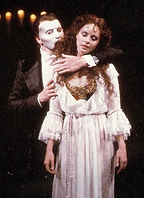
Photo credits:
Linked (left)
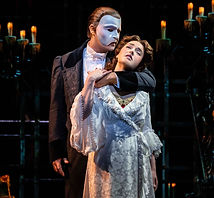
Photo credits: @phantomopera instagram
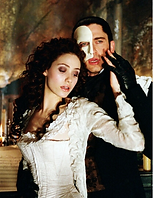
This dress is the iconic one worn during the tile song when Christine goes to the Phantom's lair for the first time, they have kept this one very similar, it is just missing the Hannibal corset underneath. I don't believe it would be well received if it was changed as it is part of the 'brand' of the musical.
Photo credits: Phantom of The Opera 2004 film
Hannibal/Think Of Me Dress
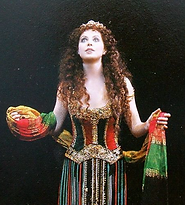

Photo credits: @phantomopera instagram
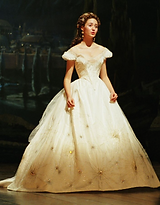
This dress is worn during Chrsitine's first solo. The dress worn in the film has a completely different aesthetic and doesn't follow the storyline. However I think they took advantage of not having to do a quick change on stage and wanted a more 'unforgettable' dress.
Photo credits: Phantom of The Opera 2004 film
Don Juan/Point Of No Return dress
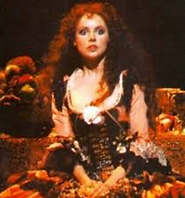

Photo credits: @phantomopera instagram

Once again the live production costume has stayed almost exactly the same whereas the film took it in a wildly different direction to a point where it is completely unrecognisable. However even though it is a very different dress, this one does still follow the storyline and makes sense that she'd wear it.
Photo credits: Phantom of The Opera 2004 film
Notes/Wishing Dress
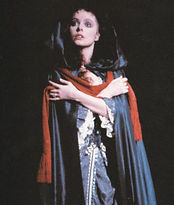
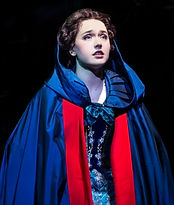
Photo credits: @phantomopera instagram
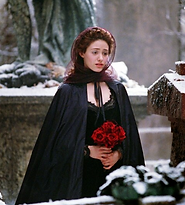
This outfit hasn't been changed as much as the last two. Christine is still wearing the cloak but both the cloak and dress are different colours but it still gives off the same vibe and fits in the scene as she is outside in the cold.
Photo credits: Phantom of The Opera 2004 film
Photo credits:
Linked (left)
Photo credits:
Linked (left)
Photo credits:
Linked (left)
My favourite actors and actresses

Photo credits: Andrea Johnson
Pictured- Lily Kerhoas and myself
A big part of my interest in musicals, besides the songs, are the characters and the people who play them. When I first saw Phantom of The Opera I was immediately amazed by the woman playing Christine Daae, the lead female role, this was Lily Kerhoas. I went to see Phantom with very limited prior knowledge and was blown away when Lily Kerhoas started singing, particularly during the title song when she sings up to an E6, which is an incredibly high note, she sung it with such power behind it I think my jaw actually dropped! I then went home and watched the 25th Anniversary recording of Phantom (over and over again). The cast in this production are outstanding, all handpicked by the writer, Andrew Lloyd Webber for the anniversary. The leading trio (The Phantom, Christine and Raoul) were played by Ramin Karimloo, Sierra Boggess and Hadley Fraser, I very quickly became fans of all three and have been lucky enough to see them all live in different shows! I saw Ramin Karimloo and Hadley Fraser as the main characters in Dirty Rotten Scoundrels which was hilarious, it was really interesting seeing them play such funny light hearted roles compared to the more dramatic and serious nature of Phantom and Raoul in The Phantom of The Opera. It goes to show how talented and versatile they are that they can play two such contrasting roles so convincingly. Sierra Boggess and Lily Kerhoas are my favourite Christine Daae actresses, I can not choose between them. Although they are both sopranos being able to sing the role of Christine, they both have quite different voices. Kerhoas sings in more of a lower key, yet still hitting the highest notes, and has a smoother voice while Boggess’ natural voice is a much higher soprano voice and uses a lot of vibrato when singing. The two actress’ also have shown their abilities to meet the requirements of other genres, and I had the pleasure of seeing them both live in different roles. While the obviously more important components in any musical are the music and lyrics, the more successful lead roles are where acting and dance are also achieved by the individual actors to a very high standard, nailing the well known phrase ‘a triple threat’.
Set Design
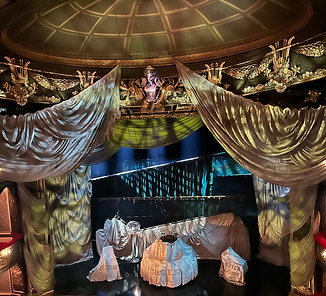
Photo credits: Myself, taken at His Majesty's Theatre in London
Scenic design, also known as stage design or set design, is the creation of scenery for theatrical productions including plays and musicals. The term can also be applied to film and television productions, where it may be referred to as production design. Scenic designers create sets and scenery to support the artistic goals of the production. More recently, scenic designers are having an increasing presence in the artistic process, as co-creators, shaping the physical and overall tone of the production. These designers work closely with the director, playwright, and other creative members of the team to develop a visual that complements the narrative and emotional tone of the production. Set design today can include multiple elements – props, backdrops, set pieces, lighting, costume and sound design. Technical tools and special effects availability will also influence set design and implementation. As a play progresses, the set directs your understanding of changes to location, time or age. It may use imagery, such as pictures, or moving scenes to depict movement. For example, the latest production of Les Miserable uses LED screens to move the character from one place to another, specifically moving through the sewer scenes and when Javert throws himself into the river, it uses the background screen to give the impression of him falling, while the actor is lifted off the ground. So - why is set design so important? The set is the first thing the audience will see when the curtain goes up, and the lighting goes down. It will direct your eyes and explain the environment. The first hush of the theatre can be magical, between the curtain rising, the audience taking in the set, in the few seconds prior to the beginning. The Phantom of the Opera. Let’s take a look at the 2011 production at the Royal Albert Hall, marking the 25th anniversary of Phantom performances. Cast and orchestra: 200 Set design: Matt Kinley, taking inspiration from the original Phantom set designer: Maria Björnson. Theatre: Royal Albert Hall Set changes: Budget for set design: difficult to find out, but the expected weekly, combined cast and production cost for Phantom in the theatre is between £600-800,000! Specific challenges for set design: chandelier, stage size, shape and position. Here is a more detailed look at the set design elements for the Royal Albert Hall Performances: Integration of Original Elements: The design was able to retain many iconic elements of the original set design, which helped the production retain its familiarity and original design. For example- The Chandelier was deconstructed and brought from His Majesty’s theatre and the set for the title song was the same with the gondola, rising candles and fog machine. However there were elements that couldn’t be adapted to use at The Royal Albert Hall- Near the beginning of the show there is a scene in a dressing room with a mirror that The Phantom appears in, they changed this so Christine was sat at just a dressing table facing towards the stage with the large screens behind her acting as a mirror, then sliding off to reveal The Phantom who then invites her to come through. Another thing is the Masquerade ball stairs, they usually perform that on a rounded staircase to the right of the stage however due to the stage and also the very much larger than usual cast, they were spread over the two staircases at either end of the stage. Projections and LED Screens: The Royal Albert Hall’s stage is better designed for concerts than plays, so they had to make use of a smaller available area. Instead of traditional scenery, the use of LED screens and projections were creatively used to depict backdrops and scenes. Like I said with the mirror, they project it as though to look like it is Christine reflected in a large mirror. They used these to replicate larger sets used in the West End show, for example during ‘All I Ask Of You’ they use the screens to show a backdrop of the roof of the opera house to make it look as though they were up on the roof. Balcony Integration: The balconies either side of the stage were altered to create uprights and form an arch, mimicking the look of an opera house, to help with the correct stage presentation. Orchestra Platform: The orchestra, usually below/in front of the stage, was placed on an elevated platform, with screens behind it which gave the impression of it being halfway up the back wall, with further projected screens making the space larger. It was also a good point of entry for the Phantom at times when he was ‘watching over’ scenes. For example when he appears after Christine and Raoul’s duet, revealing he was watching them and during ‘Wandering Child’ he is up there, this to me plays into the idea of him being a ghost/monster or something inhuman being up higher above everyone. The Chandelier: It was not safely possible to have a full falling chandelier during the Royal Albert Hall Performance. Instead, they decided to use effects to make it look like it was exploding and malfunctioning, and give a similar effect, allowing for the space constraints within the hall. This production of Phantom (that was put together impressively quick!) had to work the set changes differently, due to the large amount of space that has been created to use on the stage and the vast architectural and building differences to where they are used to performing it. There are quite a few scene changes to this long running show, however, with time, and changes to theatres, directors, set designers and many other introductions to performances over time, the sets always will have a chance to if not change, then improve in presentation, in styles, and in size or structure. This is why set design is so important a part of any performance, and always to be considered for a change.
Film VS Theatre
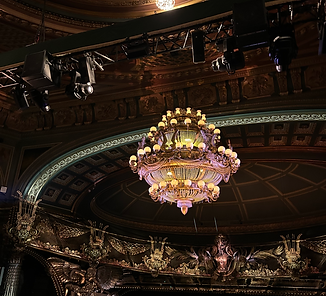
Photo credits: Myself, taken at His Majesty's Theatre in London
Phantom of the Opera is a well known and classic musical known to people around the world, it began as a novel and was adapted into a musical by Andrew Lloyd Webber in 1986. The movie was then made into a film in 2004, which unfortunately was not as successful as the stage show which is still selling out shows in London’s West End and being performed around the world in a number of different countries and languages. The Film had very mixed reviews, the main one I noticed and also have opinions on myself, was the casting of The Phantom. The Phantom is a very well known character and major leading role known for his voice and musical ability, he draws Christine in with his music and is known as ‘ The Angel of Music’, and therefore deserves to be attempted by only the strongest vocals. Gerard Butler was cast as The Phantom for the film, and whilst he can sing well and is recognised and popular in many of his acting roles, I can’t find any evidence of him having prior musical theatre experience and this comes out a bit in his singing, he has a good voice and portrays The Phantom brilliantly but I don’t feel his voice particularly suits the role. However everyone has different opinions and Butler was approved by Andrew Lloyd Webber so he will have seen something that myself and some others didn’t. Maybe I just need to watch it a few more times and try not to be as biased to my favourite Phantom! In the film they make some changes and additions to the storyline. For example in the film they go more in depth into Madame Giry and The Phantom’s past which they only hint at in the musical. When making a film they have more freedom and ability to tell a story with different sets and visuals, whereas in a live performance it is more rushed therefore meaning that the sets aren’t as realistic as films where they build detailed sets or even go to locations to film. Another change they make is the costume design, the lead female, Christine Daae, has some quite major changes in the wardrobe department which I find doesn’t always fit with the story like it does in the stage production. For example during her aria ‘Think of me’ they do a quick change on stage, the outfit is the same just with a bigger skirt to signify the importance of the new role she has taken on and it works as she is going from playing a smaller part to playing the lead. However, in the film, the dress she wears for the leading role vs a background role is very different to the rest of the cast’s, and her previous costume and doesn’t seem to fit the aesthetic of the scene in my opinion. On a more positive note, I really enjoyed the visuals of the film, the colouring was beautiful and really made it feel like the time period it was set in, in a way that live theatre is unable to do. I think that Emmy Rossum, who played Christine, had an amazing voice for the role, she had been vocally trained from a young age including opera. She was still young when filming which perfectly encapsulated Christine’s younger, and some may say, naive spirit, as she is meant to only be 20 years old and to be put in such a difficult situation. I like how Rossum plays her to be more vulnerable, as much as I love seeing Christine being strong and defending herself so well it is also good to see her in a different and more realistic light to how much this is troubling her and how she deals with it all. Her voice has a certain sound to it unlike any other Christine’s I have heard which sets her aside from them and makes the movie stand out to me more. Overall I believe the movie was a well done adaptation, with The Phantom of The Opera being such a long running and widely loved show it was inevitably going to be a difficult task, especially trying to please so many die hard fans. Despite a few things I felt it was a great movie and did an amazing job capturing the story and spirit of the musical.
Theatres I have visited
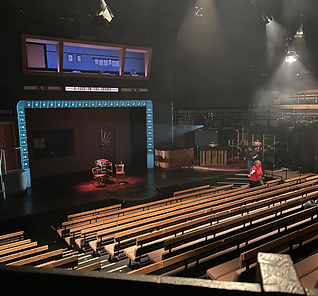
Photo credits: Myself, taken at The Young Vic in London
His Majesty's Theatre: This theatre is located in the West End of London. It is the second oldest theatre site in London. The theatre first opened in April 1907, named as The Queen’s Theatre (for Queen Anne, who commissioned it) and became known for musicals and opera. It has been rebuilt a few times, the current building rebuilt in 1892, in a French Renaissance style, and named for Queen Victoria. It has now changed name again to His Majesty’s Theatre in honour of the new King. His Majesty’s Theatre has been home to Andrew Lloyd Webber’s musical Phantom of the Opera for 38 years! It contains 1200 seats over 4 levels. The Haymarket Theatre (Theatre Royal). This theatre is also located in the West end of London, it is the third oldest London playhouse still in use. It was opened in 1720 and redesigned in 1821 with help from esteemed architect John Nash in an attempt to improve the area. Originally built in Georgian style, it was updated to Victorian Architectural style with Nash’s help. I saw Heather’s The Musical in this theatre, and it was impressive to see it, with the imposing six columns greeting people at the entrance.There are 888 seats over 4 levels. The Sondheim theatre: The Sondheim is located on Shaftesbury avenue within central London, it opened on the 8th october 1907. The theatre is named after American musical theatre composer and lyricist Stephen Sondheim, known for musicals such as Sweeney Todd and West Side Story. It is currently home to Les Miserables and has been since 2004, which was actually not written by Sondheim. It was built in The Edwardian style, the auditorium still retains some of those features. There are 1137 seats over 3 levels The London Palladium The Palladium is in Soho, London Built in 1910 it is styled with Edwardian and Art Deco features- reflecting the time period it was designed in - by Frank Matcham, with an italian frontage by John Soane. It originally was a variety house where all manner of shows were performed. It has 2286 seats over 3 levels. I particularly enjoyed a musical adaptation of the popular film ‘Dirty Rotten Scoundrels’ at the Palladium recently, with Ramin Karimloo and Hadley Fraser. The Young Vic The Young Vic is in Waterloo, London The theatre began its life in 1970, as an offshoot of the Old Vic (the first residence of the Royal National Theatre), where the focus would be on young people, developing plays and workshops for younger audiences. He wanted it to be a new kind of theatre for a new generation. This means to be easily affordable, classless, open and unconventional, and making high quality work available to all people at a low cost. The creative engagement program (Taking Part), and the Young Vic Creators Program offer artists unique pathways to gain skills and experience and has an online presence in The Genesis Network. It has a seating capacity of 550 over 3 levels. I was lucky enough to see a play/musical called ‘A Face in the Crowd’ featuring Ramin Karimloo and found it a very pleasing theatre. It was one of the smaller theatres I’ve been to which I liked as even near the back of the theatre you feel close and have an excellent view. The Lyric Theatre: Located in the Lowry Centre, is in The Salford Quays in Manchester. The Lowry Centre is a theatre and gallery complex, and was opened in April 2000 following an extensive regeneration project for the area. It is named after a painter L.S. Lowry. Set on Pier 8 of the quays, it is strategically placed to add visual harmony to the area, along with the benefit of arts and the theatre. There are 1730 seats in this theatre over 4 levels. I found it a different experience being in such a modern building, after all the historical buildings I am used to visiting for shows. It felt a little like going to the movies, as opposed to a live show. I saw ‘Nine’ with Ramin Karimloo here, and really enjoyed it despite the different environment. I understand older theatres are built to a certain design, to allow sound to travel to all audience members, before the invention of microphones and speakers, However, I do associate the closeness, almost ‘gloominess’ of the original historical theatres, with the whole entertainment experience. Cadogan hall Cadogan Hall is located in Sloane Square in London. The hall first opened in 1907 as a new christian science church until it was sold in 1996. In 2000 it became a permanent base to the royal philharmonic and was reopened as a concert hall in 2004. I’ve seen a concert about Harvey Milk there with Sierra Boggess, the environment and atmosphere was really inviting, the interior design of the hall was beautiful. It has 950 seats over two levels, despite having almost a thousand seats it feels quite close and personal with an amazing sound system.
